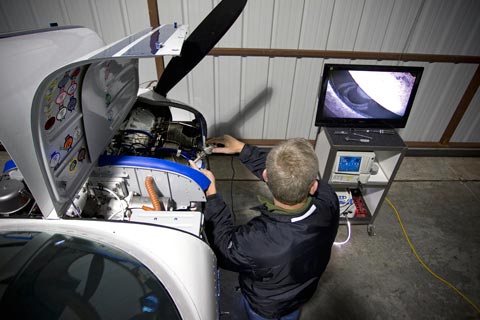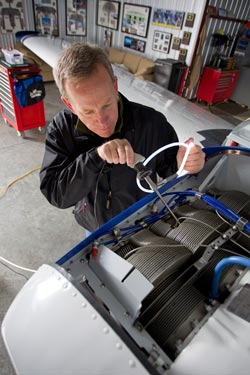Will Medicare cover this?
Medical technology for engine inspection
Advancements in medical technology may seem unrelated to aircraft engine maintenance. But miniature cameras made for viewing the inside of human bodies also make fantastic diagnostic tools for hard-to-reach areas in engines and airframes.
And a new generation of tiny, inexpensive tubular cameras that can be connected directly to laptop computers provide tremendous advantages over traditional borescopes that A&P mechanics have used for decades for similar purposes.
Adrian Eichhorn, a pilot and mechanic in Alexandria, Virginia, has pioneered the use of oral and surgical endoscopes during the past three years, and the medical devices have become a standard part of annual and prepurchase inspections he performs on Bonanzas and Barons.

“There’s only so much that oil analysis and compression checks can tell about the health of an engine,” Eichhorn said. “The weak link in big-bore Continental engines has always been the exhaust valves. Modern medical devices provide a great way to look deep inside the cylinders at the valves, guides, guide stems, cylinder walls, and piston crowns. Looking at those, and burn patterns, it’s easy to see exactly what’s going on internally.”
I recently watched Eichhorn “scope” the Lycoming O-320 engine on my RV–3, and the process was revealing, to say the least.
After removing the top spark plugs, Eichhorn rolled up a cart that held a Telicam oral endoscope, a Stryker HD surgical endoscope, a digital video processor, and a 37-inch TV screen. He’d insert an endoscope into each spark plug hole and maneuver the camera inside the cylinder. All the while, he’d watch the TV screen and note what he saw, just as a radiologist would review X-rays or CAT scans. Whenever he saw something particularly noteworthy, he’d hit a button that snapped an on-screen picture and save it to a computer file for future reference.

“That circular burn pattern on the top of the exhaust valve is just what you’d hope to see,” he said. “It shows the valve is rotating properly, and that heat is being dissipated evenly.”
The internal walls of the steel cylinders were bright and shiny and showed the patterns from being properly honed about 350 flight hours ago. Rotating the propeller by hand, Eichhorn brought the top of each piston into view and watched how closely the intake and exhaust valves seated.
The surfaces of the intake valves were clean, and the exhaust valves were more colorful—mostly orange and brown, with a few black rings—the remnants of unburned fuel. On the oversized TV screen, the exhaust valves resembled slightly overcooked pizzas.
Eichhorn has performed detailed endoscope examinations on more than 80 single- and multiengine airplanes, and he’s noticed a progression of changing colors on damaged exhaust valves.
First, the edges turn the color of cocoa, and the normally circular burn patterns become irregular as guides become worn and valves stop rotating normally. Then portions of the valves turn red. And finally, when they turn green, Eichhorn said, failure is imminent. He’s spotted severely damaged valves on several cylinders with good compressions and no outward signs of impending trouble.
Other cylinder maladies such as rust or internal cracks are obvious through the endoscope.
“Those things just jump out at you,” Eichhorn said. “They’re almost impossible not to see.”

Eichhorn said the borescopes mechanics have traditionally used for engine inspections are limited because image quality is relatively poor and the things mechanics see require a great deal of interpretation. Also, only the operator can peer inside the engine, and not the aircraft owner or maintenance manager.
 Eichhorn was convinced there had to be a better way several years ago when he came upon an alternative during a visit to his dentist, Barry Rudolph, a fellow GA pilot. Rudolph used an oral endoscope to examine Eichhorn’s molars, and the patient asked whether it would be possible to obtain a similar device for probing engines. As it turned out, Rudolph had an older endoscope that he wasn’t using and loaned it to Eichhorn to take to his hangar. Since then, fellow pilot and Baron owner Peter Wu, an anesthesiologist, made it possible for Eichhorn to obtain a newer model that provides HD images.
Eichhorn was convinced there had to be a better way several years ago when he came upon an alternative during a visit to his dentist, Barry Rudolph, a fellow GA pilot. Rudolph used an oral endoscope to examine Eichhorn’s molars, and the patient asked whether it would be possible to obtain a similar device for probing engines. As it turned out, Rudolph had an older endoscope that he wasn’t using and loaned it to Eichhorn to take to his hangar. Since then, fellow pilot and Baron owner Peter Wu, an anesthesiologist, made it possible for Eichhorn to obtain a newer model that provides HD images.
New oral endoscopes are expensive, with price tags topping $30,000. But used equipment can be found on eBay and elsewhere for a small fraction of that cost. Also, tubular cameras on flexible leads can be purchased online for less than $40, and mechanics say they fit inside cylinders and image quality is excellent.
“A great thing about medical technology is that it changes fast, and hospitals are willing to dump their old equipment as soon as the new stuff comes out,” Eichhorn said.
Eichhorn is finding myriad aviation applications for these medical devices. A recent safety bulletin on Baron and Bonanza flap actuator mounting plates is easily accomplished using an endoscope that provides a far better view of affected mounting plates and linkages than mere lights and mirrors. And engine camshafts can be examined by removing a lifter and inserting the endoscope—an alternative to the far greater effort and expense of removing cylinders or taking engines apart.
“The beauty of this technology is that you can easily share what you see with aircraft owners, and that allows people to make more informed choices,” Eichhorn said. “By documenting and saving the images, you can also monitor changes over time, and that makes it much easier to spot trends and patterns.”
Although the use of medical technology for engine inspections may seem exotic, Eichhorn said it’s easy to envision a time when miniature cameras on lighted, flexible probes will become standard equipment for aviation mechanics.
“Our inability to spot burned valves before they fail has been a problem for a long time. If these medical devices can help us do a better job, why not use them?”
E-mail the author at [email protected].


